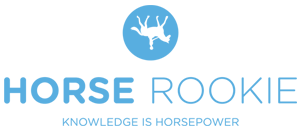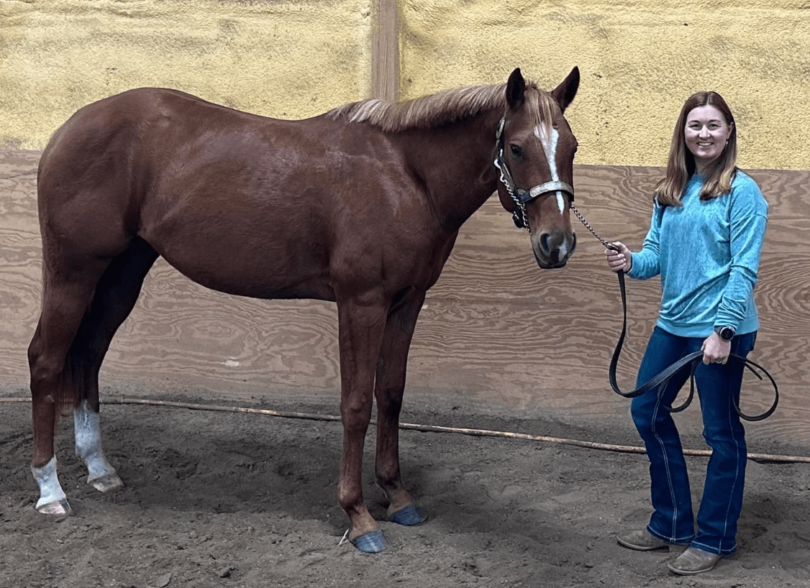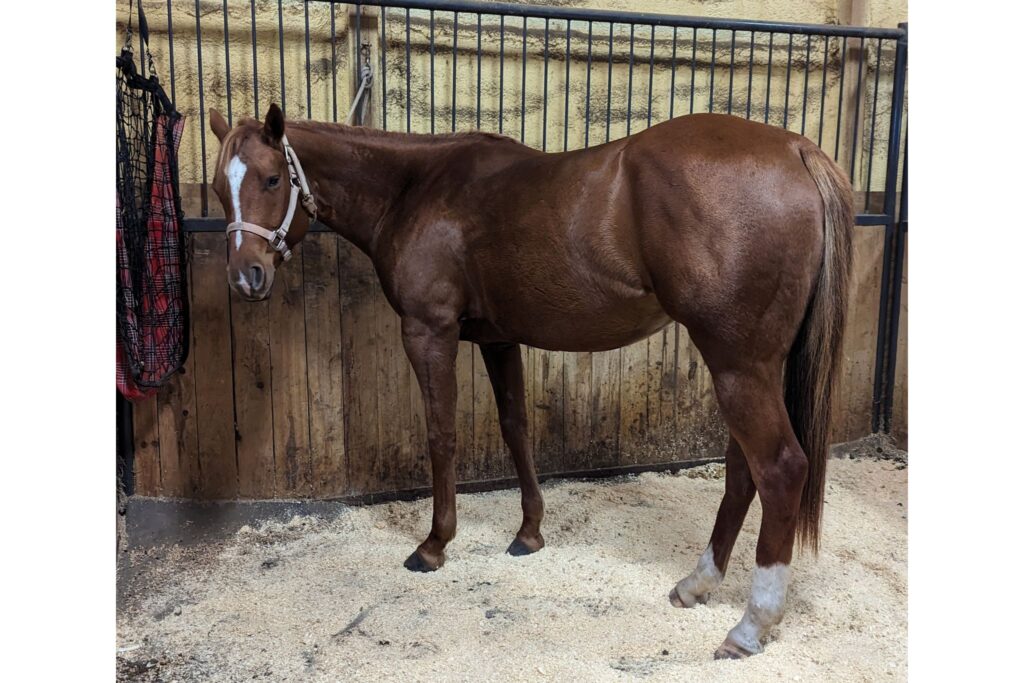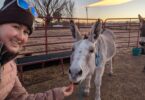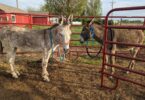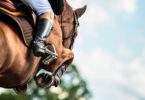A Rookie Guide to Hidden Horse Shopping Expenses
There are many factors to consider when you decide to start shopping for a new horse. Age, breed, level of training, and location are all important. But the most critical of all is likely your horse budget. Depending on your financial situation and chosen discipline, you may spend a small fortune, or you might be able to find the perfect fit for a modest price tag.
Horse shopping can be an expensive endeavor. The purchase price, however, shouldn’t be your only financial consideration. Here’s an in-depth look at my personal horse shopping journey. Spoiler alert: Happy ending!
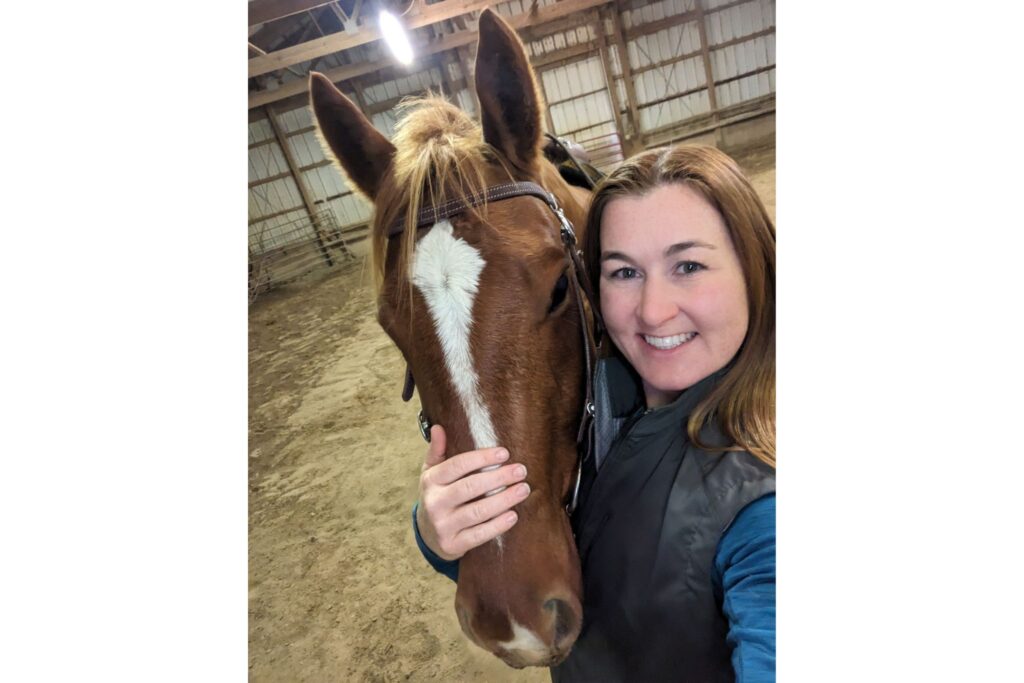
Susanna and her new horse, Ginger
The Horse Shopping Process
There are some definitive steps when you decide to purchase a new horse. Some buyers may be fortunate and quickly find the perfect fit, without a lot of stress. Others may spend months, even years trying to find the right match.
Rookie Real Life – Shopping Then & Now
(2013)
I certainly lucked out with my last show horse. The horse I had previously purchased wasn’t a good fit, so my trainer and I decided to sell him. Within six weeks, he was heading to a new owner one state away, and I was purchasing a barely-broke green horse out of my trainer’s back pasture.
I didn’t do a test ride, or a pre-purchase exam. I trusted my trainer and wrote her a (in hindsight, very modest) check literally the next day.
Three months later, we were off to our first AQHA show and started adding points to this previous blank canvas. Eight months later, we were in the top ten at the Quarter Horse Congress.

Susanna and former horse, Ridin Good N Radical, at the Quarter Horse Congress
Fast forward eight years and I was in the market for a horse again. Based on my previous experience, I had some pretty lofty expectations.
After about three months of shopping (and a lot of letdowns) I realized my budget was too low for my competitive expectations.
After increasing my budget (and learning to have a lot of patience!), I was able to find a great horse. She’s everything I could have hoped for and more! But she also cost a lot more than I initially planned on spending, and I’m not just talking about my increased budget…
Hidden Horse Shopping Expenses to Consider
- Travel Expenses while Shopping
- Pre-Purchase Exam
- Commission to your Trainer
- Transportation to Your Barn
- Horse Insurance
- Brand Inspections
- Coggins Test & Health Certificate
- Registration Transfer Fees
- New Tack & Equipment
- Feed & Supplements
Travel Expenses
I looked at horses 10 miles down the road and 10 states away from where I lived. If you’re looking for a specific type of show horse, you may need to broaden your horizons and budget for travel.
I tracked everything from fuel to airfare, hotels, and meals while on various horse-shopping trips.
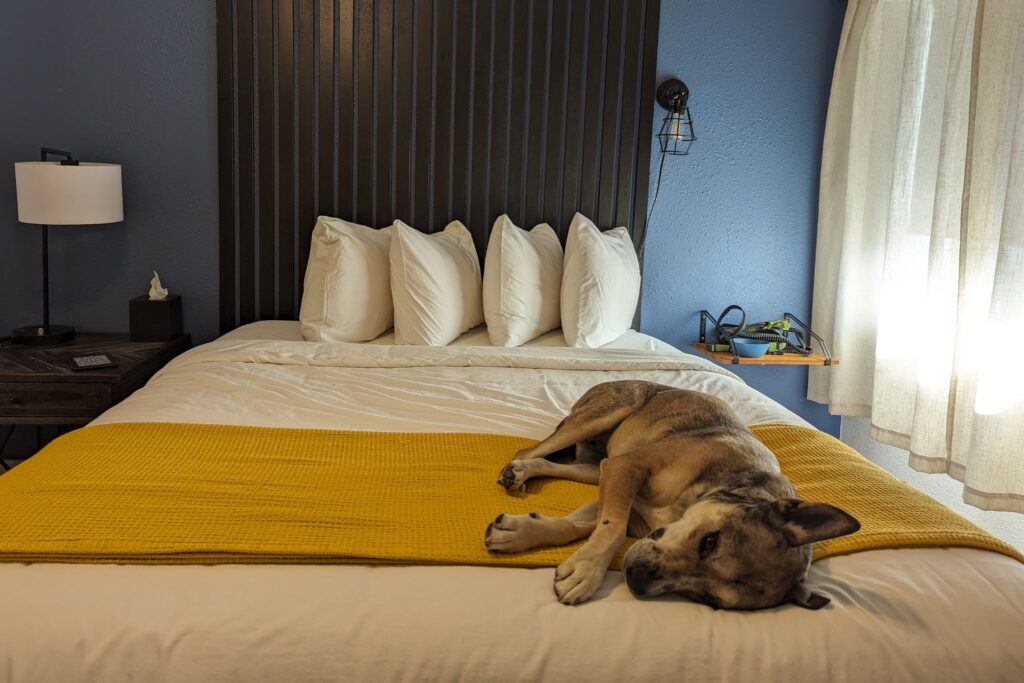
My canine horse-shopping helper
Tips for Looking at Out-of-State Horses
- Stick to your list of “must have’s.” Travel is expensive, and you should be pickier the farther away the horse is.
- Be sure to evaluate videos, get your trainer’s input, and ask a lot of questions to avoid spending money to see something you don’t actually want to buy.
- Be prepared to drop everything to go look at a horse. Sellers aren’t going to wait–someone else may snatch that horse up if you can’t be flexible with your schedule.
- It pays to pay a little extra for changeable or cancel-able travel plans. Some horses might go lame, while others sell fast. Better to build some flexibility into your plans!
Total Spent on Travel to test ride 4 horses: $1,375
Rookie Case Study
While scrolling through Facebook ads on a Sunday, I found a great gelding located in Iowa that checked all my boxes. I requested videos, got my trainer’s approval, and asked about a dozen questions. This horse seemed like a great find!
On a Tuesday evening, I confirmed a test ride for the upcoming Sunday morning. The horse was an 11 hour drive from my home, and I wasn’t able to take off any time from work that week. I planned to leave Saturday morning, camp Saturday night to save some money, do my test ride Sunday morning, then drive back home so I could be at work Monday morning.
I opted to book a rental car to avoid putting over 1,000 miles on my SUV. I’d also get better gas mileage.
The horse sold Friday night. Ugh! Fortunately, I was able to cancel my rental car the day of, so I wasn’t out any money–just four days of planning and canceled weekend plans.
Pre-Purchase Exam
If you think you’ve found the horse of your dreams, be sure to pause and prioritize a pre-purchase exam before signing over any hard-earned cash. If you have any health concerns, be sure to address them (or walk away before you invest hundreds of dollars in a PPE!)
For the record, we at Horse Rookie always recommends ponying up for a PPE before buying a horse, no matter the purchase price.
Personally, my close friends and I set that threshold at about $5,000. Under, we might skip a PPE. More than that? It’s a must.
Two horses made it to the “PPE” step of the buying process during this round of horse-shopping. You can read the full story of the first PPE here, so I won’t re-hash it in this article. I learned a LOT from that PPE, and implemented those findings for my second attempt. This allowed me to save a little money while still getting the information I needed to make an informed decision.
Tips for a Successful Pre-Purchase Exam
- Know what you’re willing to walk away from up-front (and stick to it!) I promise, there are horses out there that will pass. It just may take some work to find them!
- If there’s a red flag, bow out gracefully and don’t proceed to the PPE. You can easily spend hundreds, if not thousands of dollars on PPE’s. Save your hard-earned money for that purchase price, not on X-rays for multiple horses.
- Establish good communication with the vet performing the PPE, especially if you can’t be there in person.
- Write out exactly what you’re asking for (along with sequence and when to stop vs. proceed) is not only appreciated by the veterinarian, but could save you hundreds in unnecessary tests.
Total Spent on PPE’s for 2 Horses: $1,500
Commission to your Trainer
This can be a tough one. Personally, I’ve never paid a “finders fee” or trainer commission for buying a horse. While I did consult my trainer throughout this most-recent buying process, I did all the work of searching, finding, test riding, and coordinating PPE exams. I wanted my trainer to have input on the horse I’d be boarding with her (and riding and showing), but I was comfortable navigating much of the experience on my own.
For every 10 horses I looked at, I’d request videos on one or two. For every three horses I screened via videos, I’d pass maybe one on to my trainer to review. This allowed input while minimizing the requested time commitment.
- Did I buy my trainer (and her vet) gifts for their help during this process? Yes!
- Am I going to buy my trainer a super awesome Christmas present for all her help? Also yes!
This topic can certainly get sticky. Everyone, and every relationship, is different. Establish open communication with your trainer, and ask questions to avoid any surprises! I was unsure of etiquette and definitely phoned a friend (or two) for guidance through this process.
For the record, when trainers find, test ride, and help with the purchase process, expect to pay (at least) a 10% commission based on the purchase price.
Fun Fact: When you are insuring a horse, you can include trainer commissions paid in the insured value of the animal.
Total Spent: $288 in gifts
Transportation
So you’ve found your dream horse. You had a great test ride, and it passed the PPE. Now, you need to bring it home!
I purchased a horse in North Dakota, in November. First, North Dakota is “off the beaten path” and not a state serviced by nation-wide transportation companies.
Second, I bought a horse in November, when most normal horse-hauling operations cease for the winter due to snow and ice making for unsafe hauling conditions.
How did we handle this 10-hour transportation puzzle? By posting on social media and leveraging social networks. And it couldn’t have worked out better!
We were able to find someone hauling a weanling from North Dakota to South Dakota. This cut our trip in half–so we met up in Deadwood, South Dakota for a transfer. While this made for a VERY long day for everyone involved, it allowed us a lot of control over the hauling experience while minimizing our costs.

Fun Fact: When you are insuring a horse, you can include transportation fees (if using a commercial hauler) in the insured value of the animal.
Total Spent on Transportation: $1,100
Horse Insurance
You’ve just spent thousands of dollars on your horse and the buying process. Why not protect that investment?
Previously, I’ve carried mortality insurance on my horses. This has been fairly inexpensive, as my horses weren’t valued for more than $10,000. My shopping budget, however, has increased and I know vet bills have gone up with inflation. So, this time around, I opted to up my insurance needs, which of course, resulted in a higher annual premium.
After asking around within my equine network, I decided on Markel Equine Insurance. With mortality insurance, emergency colic surgery coverage, and some basic major medical coverage, my annual insurance premium came in at a little over $1,000 for the year.
Fun Fact: Figure out insurance before transporting your horse! The policy won’t go into effect if your horse is actively being transported when you are filling out paperwork.
Total Spent on Insurance: $1,138 (annually)
Brand Inspections
Since I bought a horse in North Dakota and live in Colorado, I have to schedule a brand inspection on my new horse to establish ownership. In Colorado, I need the current brand inspection card (from North Dakota) along with a bill of sale proving the transfer of ownership.
If you live in one of the 13 states requiring brand inspections, this is an important factor you don’t want to gloss over!
Colorado charges $35 for a permanent brand inspection card. While this is a minimal dollar expense, it’s a significant time commitment, as I need to be present (in person) to complete all the paperwork. This equals a half-day of vacation.
Total Spent: $35
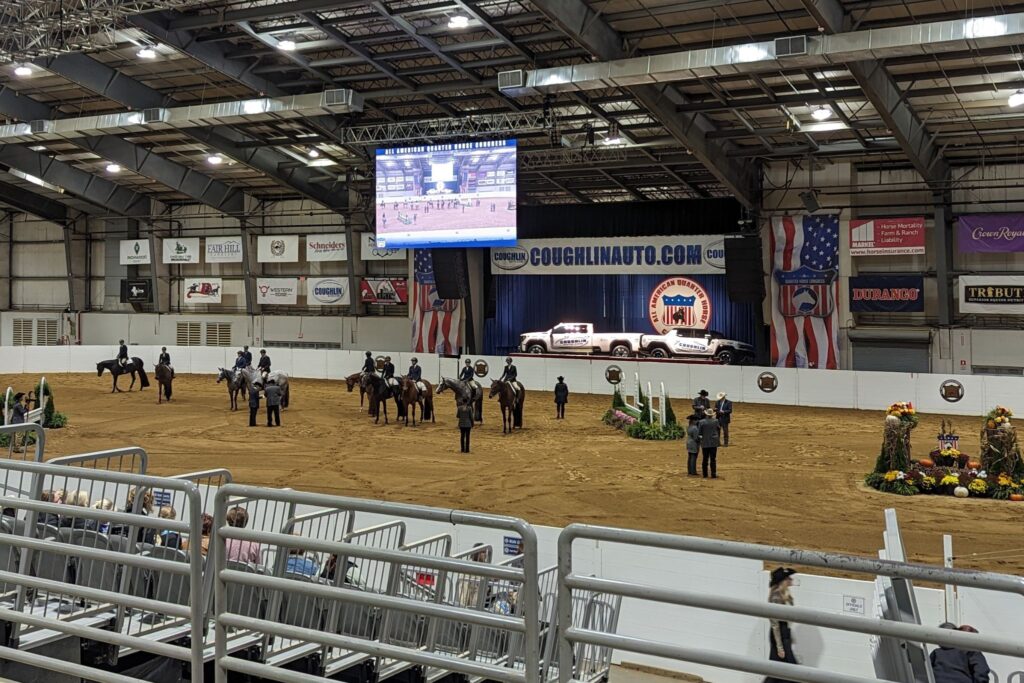
Coggins Test & Health Certificate
If you’re crossing state lines, chances are good you’ll need a health certificate. This is a veterinarian-issued paper certifying your horse is in good health.
You’ll need the address of origin and destination to complete a health certificate. Most health certificates will also require a negative Coggins test. Depending on the state(s) impacted, Coggins tests can be good for up to a year.
I was able to get my health certificate as part of my PPE, which cut down on another trip to the vet and physical.
While this particular expense is a low $ investment, it can require a high amount of time to figure out.
Total Spent: $38
Registration & Transfer Fees
Since I bought a registered Quarter Horse, I’ll have to submit transfer paperwork (with a fee) to transfer ownership to my name. I mailed the paperwork with a tracking number, which added some extra cost.
AQHA transfer fees require that you be a current AQHA member, and costs $40 per horse in 2023.
Total Spent: $49
New Tack & Equipment
I already owned a ton of riding gear, from work saddles, tack & clothing to show saddles. One of the first things I did was to haul it all out to the barn and try it on my new horse!
Since I was transitioning from an English-style, senior, All Around gelding to a Western prospect, junior mare, I knew not everything would fit. Fortunately, most of my tack (and show clothes) would translate from one horse to another.
New Horse Shopping List:
- Mid-weight blanket (old horse was an 82”, new is 76”). Expect to spend $180.
- English bridle (horse-size is too big; need to get a Cob size). Expect to spend $150.
- Leather halter (horse-size is also too big). Expect to spend $100.
- Fake Tail (sold previous with my old horse, not to mention it wouldn’t have matched!). Expect to spend $285.
- Western show pad (new color scheme was needed!). Spent $200.
While my Western wardrobe needs a refresh, most of my tack, grooming equipment, and gear will translate to the new horse.
Some people will spend more on tack and equipment than the horse itself!
Total Spent: $915
Feed & Supplements
After spending (likely) thousands of dollars buying, vetting, and transporting your new horse, you don’t want to cut any corners. Ensure a smooth transition and purchase enough feed to safely transition your horse from their old feed to their new.
I went to Tractor Supply and picked up a bag of Purina Ultium Competition feed so we could slowly transition my horse from that to my trainer’s grain-of-choice.
Major feed companies recommend switching 10% per day.
So, it should take a minimum of 10 days to switch from one grain to another.
It’s important not to overlook transitioning hay as well! My new horse was fed grass and alfalfa hay previously. I was able to get a bale of each from the sellers so we could transition slowly. We fed half old / half new until we ran out of the old hay.
You can also feed ProBios to help mitigate the stress of adapting to a new environment. We fed Probios horse treats during transport, and the powder as a topdress for a week after transfer. I already had Probios on-hand to feed to my donkeys, so I didn’t need to spend any extra money here.
I’d also suggest giving UlcerGard the day of transport to minimize stress and the risk of ulcers. The sellers covered this for us.
Overall, the cost to transition your horse from old feed to new is minimal. But, the risk of not making a proper transition is high.
Total Spent: $35
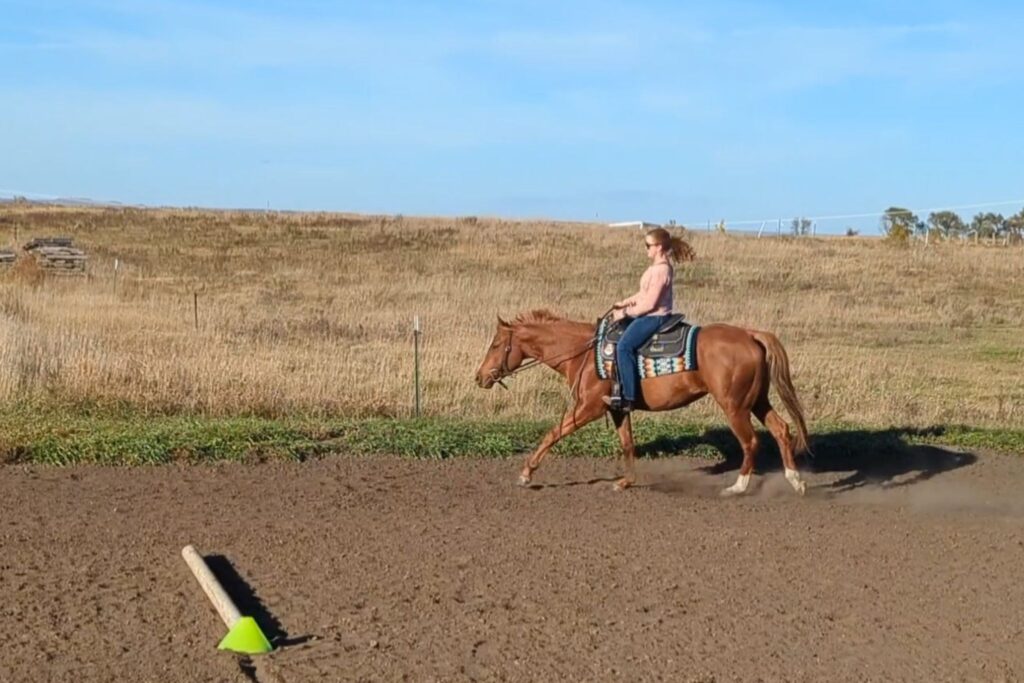
Test riding what would become my new mare!
Frequently Asked Questions
Q: What are the monthly costs of owning a horse?
Monthly horse care expenses can vary dramatically depending on where you live and where you keep your horse. If you board, expect to spend $350-$1,000 per month in boarding fees. Don’t forget to budget for tack, supplements, lessons and training, farrier expenses, and veterinary expenses.
Q: Why are horses so expensive to buy?
Horse ownership rises along with inflation. There are many factors that influence a horse’s purchase price, including breed (and bloodlines), age, amount of training, location, conformation, show record, and maintenance expenses.
Q: What is the cheapest state to own a horse?
Those living in Kentucky, Alabama, Mississippi, and Arkansas are in luck! These are some of the least expensive states to own horses in.
The most expensive states include Hawaii, California, New York, and New Jersey.
Parting Thoughts
None of these expenses are very significant on their own, but together, they certainly add up.
My total expenses, beyond purchase price, was $6,473.
For the record, I didn’t realize how expensive this was until I added it all up! I was able to spread this out over the course of 6 months, but it wasn’t cheap.
It’s always better to be prepared, protect your investment, and avoid unexpected expenses so you can create and follow a budget that you are comfortable with.
P.S. Enjoy this article? Trot on over to:
- How Much Horses Cost & How You Can Afford One
- Dream Horse Delivered: How to Buy Your First Horse
- Horse Budgeting 101: How to Set Yourself Up for Success
- First Time Horse Ownership: A Helpful Beginner’s Guide
- Are You (Really) Ready for a Green Broke Horse?
- Beginner’s Guide to Equine Insurance
- Peace Of Mind: Pre Purchase Exam Checklist
- 60 Questions to Ask When Buying Your Dream Horse
Sources:
Purina Ultium Competition Horse Formula Feed, 50 lb. at Tractor Supply Co.
How much does a transfer cost?
Livestock Inspection | Department of Agriculture
